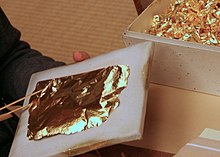

|
Removing hatnote per WP:NOTAMB and WP:RELATED
Tags: Mobile edit Mobile app edit iOS app edit
|
replace template with {{unsourced}}
|
||
| (7 intermediate revisions by 7 users not shown) | |||
| Line 1: | Line 1: | ||
{{Short description|Extremely thin sheet of metal}} |
|||
{{Unreferenced|date=May 2009}} |
|||
{{Unsourced|date=February 2022}} |
|||
[[File:Kanazawa Gold Factory.jpg|thumb|Metal leaf processing]] |
[[File:Kanazawa Gold Factory.jpg|thumb|Metal leaf processing]] |
||
| Line 8: | Line 9: | ||
[[Vark]] is a type of silver leaf used for decoration in Indian cuisine. |
[[Vark]] is a type of silver leaf used for decoration in Indian cuisine. |
||
[[Goldbeating]], the technique of producing metal leaves, has been known for more than 5,000 years. A small gold nugget 5 |
[[Goldbeating]], the technique of producing metal leaves, has been known for more than 5,000 years. A small gold nugget 5 mm in diameter can be expanded to about 20,000 times its initial surface through hammering, producing a gold foil surface of about one half square meter with a thickness of 0.2–0.3 [[micrometre|μm]]. |
||
==Nanjing gold leaf forging technique== |
|||
===History=== |
|||
This is a traditional handicraft in [[Nanjing]], produced as early as the [[Three Kingdoms]] and Two Jin Dynasties; it was used in Buddha statue manufacturing and construction. It was widely used in the gilding of Buddha statues and idols and the construction industry during the Eastern Wu and [[Jin dynasty (266–420)|Eastern Jin Dynasties]].<ref>{{cite web |url= http://www.designartj.com/bzgcysb/ch/reader/create_pdf.aspx?file_no=201414015&year_id=2014&quarter_id=14&falg=1|title= “南京非遗”文化视域下的家具产品创新设计研究 |publisher= (金陵科技学院,南京 211169)|author=叶聪|date= 2014-07-15 }}</ref> |
|||
During the Qing Dynasty, (1640-1912) the technology developed, and Nanjing gold leaf was sold overseas. It retaines traditional [[smelting]], hand-beating and other techniques, and the gold leaf is pure, uniform and soft. On May 20, 2006, it was included in the first batch of national intangible cultural heritage representative items.<ref>{{cite web|url=https://www.ixueshu.com/document/b0ff6817b7e4d09e.html|title=第一批國家非物質文化遺產-南京金箔锻制技艺|publisher=愛學術|access-date=2021-07-30}}</ref><ref>{{cite web|url=http://www.goldfoil.com/mobile/detail.aspx?id=266|title=南京金箔鍛製技藝|publisher=龍媒網|access-date=2021-08-02}}</ref><ref>{{cite web |url= http://lotustimes.com.mo/national_education/222 |title= 【國家級非物質文化遺產系列玖】南京金箔鍛製技藝 |publisher= 蓮花時報 |access-date= 2021-08-11 }}</ref><ref>{{cite web|url=https://m.fx361.com/news/2019/0805/5379496.html|title=南京金箔鍛製技藝|publisher=參考網|author=管秋惠|access-date=2021-08-11}}</ref> |
|||
Modern gold leaf artists combine ancient traditional crafts with modern technology to make traditional gold leaf. Forging skills are more sophisticated.<ref>{{cite web |url= http://culture.people.com.cn/BIG5/n1/2019/0520/c1013-31092639.html|title= 古老技藝“點亮”現代生活 金箔文創亮相南京 |publisher= 中國新聞網 |date= 2019-05-20 }}</ref><ref>{{cite web |url= https://gb.global.cnki.net/kcms/detail/detail.aspx?filename=1017278778.nh&dbcode=CMFD&dbname=CMFD2018&v=|title= 南京金箔传统锻制技艺的保护与传承研究 |author=丁婷|publisher= 博碩論文_南京師範大學 |date= 2019-05-20 }}</ref> |
|||
=== Nanjing Gold foil forging technology. === |
|||
The gold foil production in [[Nanjing]] follows the ancient production process. The forging process has been tempered by more than a dozen processes such as gold bar, leaf beat, twisting, opening, assembly, issuing, and foil cutting. It is also called "playing gold leaf." According to the needs of different products, a proportion of silver and copper is added; the metal is then melted into liquid, poured into an iron tank and cooled to form gold bars, hammered into thin slices, cut into small gold pieces, and then covered with gold foil and hammered into gold foil repeatedly at high temperature.<ref>{{cite web |url= http://www.macaodaily.com/html/2020-08/16/content_1454722.htm|title= 萬錘鍛製箔金來 |publisher= 澳門日報 |date= 2020-08-16 }}</ref><ref>{{cite web |url= https://www.suinian.com/book/1486/576683.html|title= 南京金箔锻制技艺 |publisher= 学科分类—综合性图书 五洲传播出版社《中国辞典》第327页 |date= 2021-11-14 }}</ref><ref>{{cite web |url= http://sn.people.com.cn/BIG5/n2/2020/0716/c378306-34160388.html|title= 南京金箔——萬錘鍛制箔金來 |publisher= 新華網 |date= 2020-07-26 }}</ref><ref>{{cite web |url= http://jsnews.jschina.com.cn/nj/a/201703/t20170307_176107.shtml|title= 南京金箔博物馆免费开放 |publisher= 揚子晚報 |date= 2017-03-07 }}</ref><ref>{{cite web |url= http://www.ourjiangsu.com/a/20210217/1613558994560.shtml|title= 当春联遇上非遗!金陵金箔“闹新春” |publisher= 我苏网 |date= 2021-02-17 }}</ref> |
|||
==Gallery of gold leaf== |
|||
<gallery> |
|||
File:goldleaf.jpg|22k gold leaf applied with an ox hair brush during the process of [[gilding]] |
|||
File:Small gold nugget 5mm dia and corresponding foil surface of half sq meter.jpg|A 5 mm gold nugget beaten to a one half square meter square of foil |
|||
File:burnishing.jpg|[[Burnishing (metal)|Burnishing]] gold leaf with an [[agate]] stone tool during the water gilding process |
|||
</gallery> |
|||
==See also== |
==See also== |
||
| Line 33: | Line 16: | ||
==References== |
==References== |
||
{{reflist}} |
{{reflist}} |
||
==Further reading== |
|||
* {{cite web|url=https://johncanningco.com/blog/gilding-in-architecture-when-where-why-it-was-used/|title=Gold Leaf in Architecture: When, Where, & Why It Was Used|access-date=25 October 2023|work=johncanningco.com|archive-url=https://web.archive.org/web/20230328172849/https://johncanningco.com/blog/gilding-in-architecture-when-where-why-it-was-used/|archive-date=28 March 2023}} |
|||
{{Authority control}} |
|||
[[Category:Gold]] |
[[Category:Gold]] |
||
| Line 38: | Line 26: | ||
{{ |
{{art-material-stub}} |
||
This article does not cite any sources. Please help improve this articlebyadding citations to reliable sources. Unsourced material may be challenged and removed.
Find sources: "Metal leaf" – news · newspapers · books · scholar · JSTOR (February 2022) (Learn how and when to remove this message) |

Ametal leaf, also called composition leaforschlagmetal, is a thin foil used for gilding and other forms of decoration. Metal leaves can come in many different shades. Some metal leaves may look like gold leaf but do not contain any real gold. This type of metal leaf is often referred to as imitation leaf.
Metal leaves are usually made of gold (including many alloys), silver, copper, aluminium, brass (sometimes called "Dutch metal" typically 85% Copper and 15% zinc) or palladium, sometimes also platinum.
Vark is a type of silver leaf used for decoration in Indian cuisine.
Goldbeating, the technique of producing metal leaves, has been known for more than 5,000 years. A small gold nugget 5 mm in diameter can be expanded to about 20,000 times its initial surface through hammering, producing a gold foil surface of about one half square meter with a thickness of 0.2–0.3 μm.
| Authority control databases: National |
|
|---|
This article related to art materials is a stub. You can help Wikipedia by expanding it. |